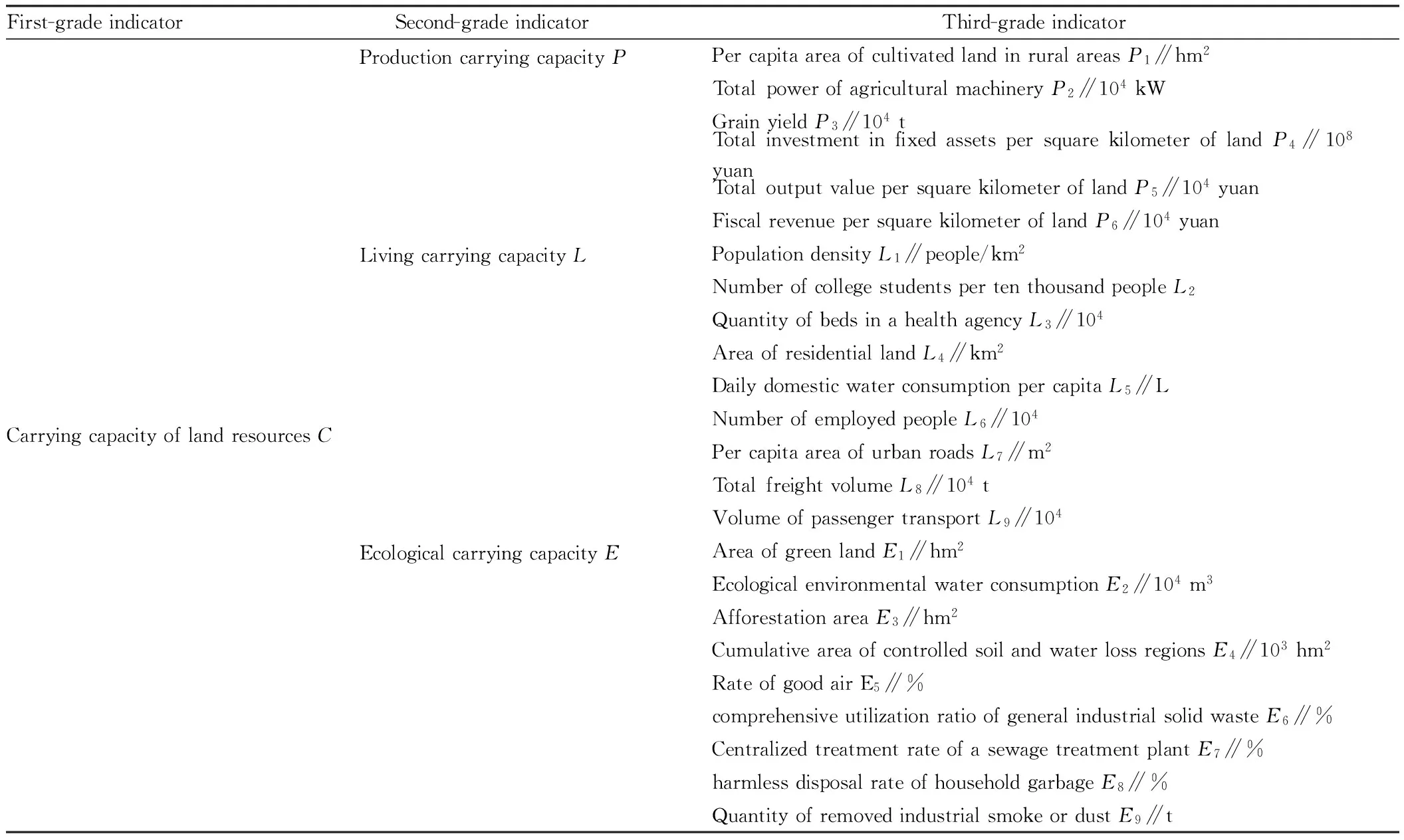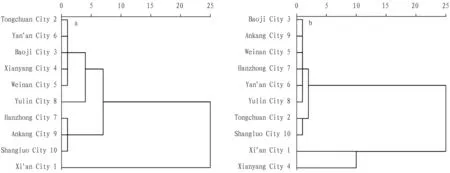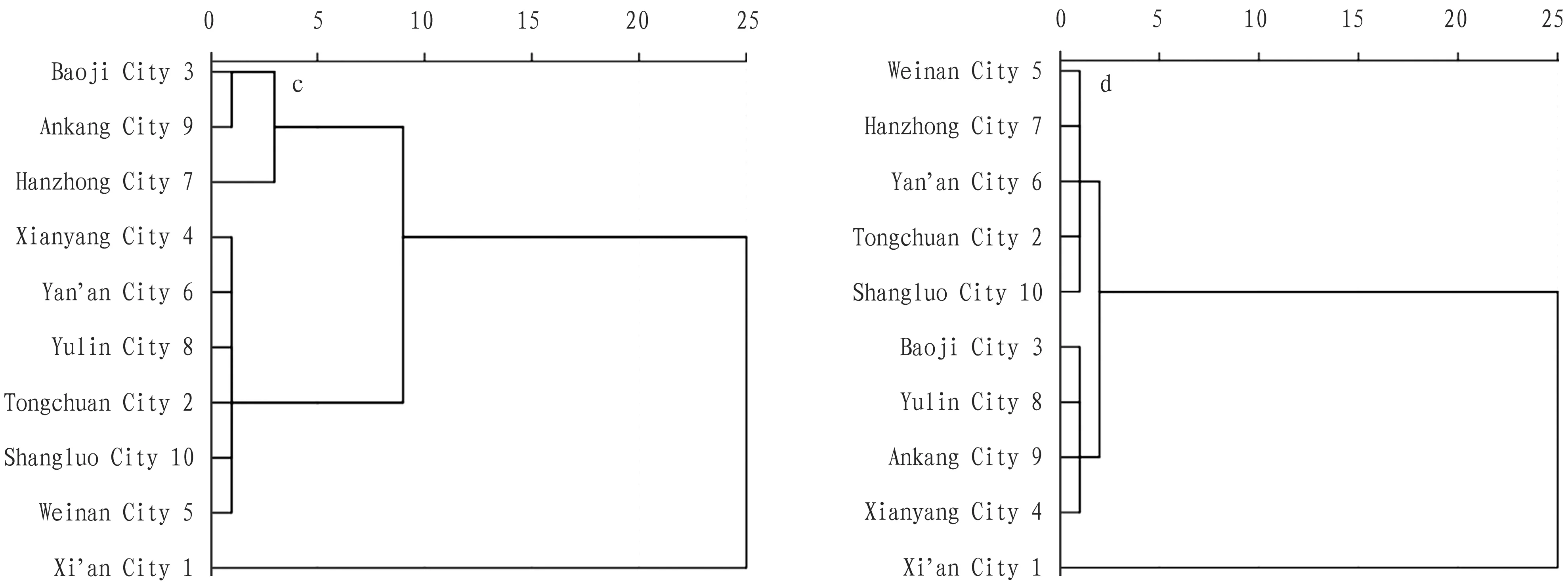Assessment of Comprehensive Carrying Capacity of Land Resources Based on Land Functions
2016-01-12
Engineering University of CAPF, Xi’an 710068, China
1 Introduction
Carrying capacity of land resources refers to the limits of scale and intensity of human activities carried by land resources under certain social, economic, ecological and environmental conditions in a space during a certain period[1]. Shaanxi’s economy is facing the new normal of speed change, structural optimization and power transformation and is changing from factor-driven and investment-driven into innovation-driven. Under the background of land resources facing high pressure in Shaanxi Province, to protect and improve ecologically fragile areas and environmental degradation area in Shaanxi Province, how to scientifically plan, optimize and reasonably arrange limited land resources to make them carry high-intensity economic activities caused by population increase and economic growth has become a hot spot and key point of current research. At present, some scholars in China have studied and explored carrying capacity of land resources. For instance, Guo Yanhong set up an index system to evaluate carrying capacity of land resources from population, construction scale, economy and ecology, and an empirical analysis of Beijing City was conducted[2]. Based on land carrying capacity index (LCCI) model, the spatial and temporal distribution of carrying capacity of land resources in Gansu Province during 1985-2010 were assessed[3]. Sun Yuetal. suggested that there were obvious spatial differences between prefecture-level cities in Shandong Province in the coordinated development degree of land comprehensive carrying capacity, and the coordinated development level of land system still had great potential to be dug[4]. Based on the relationship between population and food, a model of carrying capacity of land resources was established firstly, and total output of gain and development characteristics of carrying capacity of land resources in various counties of Hunan Province were analyzed; the relationship between carrying capacity of land resources and regional economic development was discussed, and then relevant development strategies were proposed[5]. In Xi’an City, Shaanxi Province, the dynamic changes of land comprehensive carrying capacity during 2000-2007 were shown as "medium-low-medium-high", showing an increasing trend on the whole, and the decrease in the land comprehensive carrying capacity was mainly caused by the reduction of natural carrying capacity and environmental carrying capacity[6]. It is clearly seen that in most studies on land carrying capacity, the spatial and temporal distribution of carrying capacity of land resources were analyzed and assessed based on the establishment of an indicator system. Guo Huanhuanetal. assessed carrying capacity of land resources from the carrying capacity of land production, land space, land ecology, and land security, but few indicators were chosen and could not reflect the carrying capacity of land resources fully. Therefore, based on relevant research results, from the perspective of land use functions, an evaluation indicator system of carrying capacity of land resources containing production, living and ecological functions was established, and the carrying capacity of land resources in ten cities of Shaanxi Province in 2013 was assessed and analyzed to provide references for relevant studies.
2 Establishment of an indicator system and research methods
2.1EstablishmentofanindicatorsystemIn theSuggestionsofAcceleratingEcologicalCivilizationConstructionProposedbytheStateCouncilandtheCentralCommitteeoftheCommunistPartyofChinaissued in 2015, it is proposed that land is the spatial carrier of ecological civilization construction, and it is needed to implement the strategy of development priority zones unshakably, improve spatial planning system, scientifically and reasonably arrange and renovate production space, living space and ecological space. Land functions can be divided into production, living and ecological function. Based on related research achievements to land carrying capacity[8-11], following the principles of scientific nature, operability of data, and particularity of a region, various land functions were used to establish an evaluation indicator system of carrying capacity of land resources in Shaanxi Province according to local conditions of Shaanxi Province (Table 1). Classification of indicators was conducted based on the related research achievements to division of land functions. According to the actual situation of land use in each city of Shaanxi Province, plot ratio and building density were not chosen due to lack of available data.
Table1TheevaluationindicatorsystemofcarryingcapacityoflandresourcesinShaanxiProvince

First-gradeindicatorSecond-gradeindicator Third-gradeindicatorCarryingcapacityoflandresourcesCProductioncarryingcapacityPLivingcarryingcapacityLEcologicalcarryingcapacityEPercapitaareaofcultivatedlandinruralareasP1∥hm2TotalpowerofagriculturalmachineryP2∥104kWGrainyieldP3∥104tTotalinvestmentinfixedassetspersquarekilometeroflandP4∥108yuanTotaloutputvaluepersquarekilometeroflandP5∥104yuanFiscalrevenuepersquarekilometeroflandP6∥104yuanPopulationdensityL1∥people/km2NumberofcollegestudentspertenthousandpeopleL2QuantityofbedsinahealthagencyL3∥104AreaofresidentiallandL4∥km2DailydomesticwaterconsumptionpercapitaL5∥LNumberofemployedpeopleL6∥104PercapitaareaofurbanroadsL7∥m2TotalfreightvolumeL8∥104tVolumeofpassengertransportL9∥104AreaofgreenlandE1∥hm2EcologicalenvironmentalwaterconsumptionE2∥104m3AfforestationareaE3∥hm2CumulativeareaofcontrolledsoilandwaterlossregionsE4∥103hm2RateofgoodairE5∥%comprehensiveutilizationratioofgeneralindustrialsolidwasteE6∥%CentralizedtreatmentrateofasewagetreatmentplantE7∥%harmlessdisposalrateofhouseholdgarbageE8∥%QuantityofremovedindustrialsmokeordustE9∥t
2.2Researchmethods
2.2.1Standardization of evaluation indicators. Carrying capacity of land resources means evaluation of many indicators, but the dimensions of various indicators are different. To avoid the adverse effects of various dimensions on assessment results, it is needed to standardize each indicator. According to attributes, the indicator were divided into efficiency indicators and cost indicators. The larger the value of an efficiency indicator is, the better the indicator is; the smaller the value of a cost indicator is, the better the indicator is. Their calculation formulas are shown as follows[12]:
Efficiency indicators:

(1)
Cost indicators:

(2)
In the above formulas,Xijis the standardized value of an assessment indicator;i=1,2,…,n;j=1,2,…,m;Yj(max)andYj(min) are the maximum and minimum of the assessment indicator.
2.2.2Determination of indicator weight. Determination of indicator weight is key to comprehensive evaluation of multiple indicators. Methods to determine indicator weight can be grouped into subjective and objective weight methods. Subjective weight methods mean experts subjectively determine indicator weight based on their experience, such as Delphi method, Analytic Hierarchy Process (AHP),etc. The methods have been studied early and have become mature at present. However, they have poor objectivity and are affected subjective factors inevitably, and their workload is heavy. By using objective weight methods, the weight of an indicator is calculated according to the dispersion degree of data. Objective weight methods have strong objectivity and have good practical value due to clear concept, clear meaning, and simple calculation, such as Principal Component Analysis (PCA), mean squared error method, maximizing deviation method, entropy value method, and so forth. In this paper, indicator weight was determined by using mean squared error method. To calculate the weight of an assessment indicatorWj, it is needed to calculate the averageEjof standardized valueXijof the indicator firstly and then the mean squared errorFj. Their formulas are shown as follows:
(3)

(4)
(5)
2.2.3Determination of carrying capacity index of land resources. An evaluation indicator system of carrying capacity of land resources is a complex system with many layers and factors, where various indicators are interdependent, restrict each other and have great contribution to assessment results. Carrying capacity index of land resourcesCcan be calculated according to the follow-up formula:
(6)
2.2.4Clustering of evaluation indicator values of the carrying capacity. Cluster analysis, a main classification method to study samples and indicators in multivariate statistical analysis, is used to measure the similarity of different data sources and group data sources into various clusters[14]. Among cluster analysis methods, the hierarchical clustering method is most commonly used. Its basic idea is shown as follows: firstly,nsamples needing to be clustered are regarded as a class each, so there arenclasses; afterwards, clustering statistics of every two classes are calculated by using the chosen method, namely a certain distance, and the two classes having the closest relationship are merged into one class, son-1 classes are obtained; the distance between the new class and other classes is calculated by using the above method, and the two classes having the closest relationship are merged into one class, son-2 classes are obtained; the clustering process is repeated many times until all samples (or variables) are merged into one class finally.
3 Calculation and analysis of carrying capacity of land resources
3.1DatasourcesData used in this study are from theStatisticalYearbookofShaanxiProvince(2014),RegionalStatisticalYearbookofShaanxiProvince(2014),andYearbookofChina’sCities(2014). Yangling Demonstration Area, as a dependent region, is administered by Shaanxi Province. Due to the deficiency of indicator data, indicator data of other cities except for Yangling Demonstration Area were collected and used to calculate and analyze carrying capacity of land resources in Shaanxi Province.
3.2AssessmentofcomprehensivecarryingcapacityoflandresourcesBased on the evaluation indicator system of carrying capacity of land resources in Shaanxi Province and the above formulas, the production, living, ecological and comprehensive carrying capacity index were obtained (Table 2). To analyze the characteristics of comprehensive carrying capacity in various cities in Shaanxi Province better, the hierarchical clustering of production, living, ecological and comprehensive carrying capacity in the ten cities was conducted (Fig.1). According to Table 2 and Fig.1, it is found that the carrying capacity of land resources in Shaanxi Province has follow-up features.
Firstly, the three types of carrying capacity in most cities of Shaanxi Province are shown as follows: ecological carrying capacity>living carrying capacity>production carrying capacity, and the differences between various regions in a single type of carrying capacity basically accorded with the actual situation of development in each city. In the clustering of production carrying capacity, Xi’an City belonged to the first class, and Tongchuan, Yan’an, Baoji, Xianyang, Weinan, and Yulin cities belonged to the second class, while Hanzhong, Ankang, and Shangluo cities belonged to the third class. In the clustering of living carrying capacity, Xi’an City belonged to the first class, and Xianyang City belonged to the second class, while Tongchuan, Shangluo, Baoji, Ankang, Weinan, Hanzhong, Yan’an, and Yulin cities belonged to the third class. In the clustering of ecological carrying capacity, Xi’an City also belonged to the first class, and Baoji, Ankang, and Hanzhong cities belonged to the second class, while Xianyang, Yan’an, Yulin, Tongchuan, Shangluo, and Weinan cities belonged to the third class. According to Table 2, the three types of carrying capacity in Tongchuan, Baoji, Weinan, Yan’an, Hanzhong, Yulin, Ankang, and Shangluo cities are shown as follows: ecological carrying capacity>living carrying capacity>production carrying capacity, and the proportion of these cities in the ten cities was 80%; the three types of carrying capacity in Xi’an and Xianyang cities are shown as follows: living carrying capacity>ecological carrying capacity>production carrying capacity, and the proportion of these cities in the ten cities was only 20%.
According to Table 2 and Fig.1, due to unique natural, economic and cultural advantages, the production, living, and ecological carrying capacity in Xi’an City were higher than that of other cities. In Tongchuan, Yan’an, Baoji, Xianyang, Weinan, and Yulin cities, because of aggregation of resources and energy, location advantages, and scientific and technological strength, the ecological carrying capacity was high. Due to natural, historical and social reasons, productivity development lagged behind, and economic and social level were low in Hanzhong, Ankang, and Shangluo cities, so the production carrying capacity was also low. Depending on the advantages and influence of Xi’an City as an international metropolis, its public service, education resources, infrastructure, and traffic conditions were superior to that of other cities, so the living carrying capacity in Xi’an City was the highest. With the continuous implementation of economic integration and gradual acceleration of development in Xixian New Area, Xi’an and Xianyang cities were interdependent in economy, merged with each other in industry, and shared education resources and other information, building a new road of urbanization with Chinese characteristics and according with the actual situation of Shaanxi Province. As a result, the living carrying capacity was high in Xianyang City. Seen from education, medical service, transport, infrastructure, and public service, Xi’an and Xianyang cities were inferior to other cities, so the living carrying capacity was low in these cities.
Table2CarryingcapacityindexoflandresourcesinvariouscitiesofShaanxiProvince

CityProductioncarryingcapacityPLivingcarryingcapacityLEcologicalcarryingcapacityEComprehensivecarryingcapacityCOrderofcomprehensivecarryingcapacityXian0.08740.25890.19360.54001Tongchuan0.03300.03200.11540.18059Baoji0.02930.07630.15810.26374Xianyang0.03840.16460.10990.31282Weinan0.04040.06830.10280.21157Yanan0.03310.06430.10870.20618Hanzhong0.00810.07120.13570.21506Yulin0.05640.10080.11150.26873Ankang0.00940.07790.15920.24655Shangluo0.00530.04090.11870.164910


Fig.1Clusteringtreediagramsofproduction(a),living(b),ecological(c)andcomprehensive(d)carryingcapacityoflandresourcesinShaanxiProvincein2013
Through the implementation of the projects haze control by a strong hand and moistening Xi’an by eight rivers, Xi’an would be built into a national ecological garden city and forest city, where the area of urban green land, ecological water surface and wetland was increased, so its ecological carrying capacity ranked firstly in the province. ThePlansforEconomicandSocialDevelopmentinDanjiangkouReservoirAreaandItsUpperReachesissued in 2012 improved the development of Ankang and Hanzhong cities to a national strategy, bringing a rare opportunity for the protection of ecological environment in the two cities. The continuous control of rural environment and control of Weihe River basin had promoted the construction of ecological, livable and beautiful Baoji. Meanwhile, Ankang is located in Daba Mountains, and Hanzhong and Baoji are situated in Qingling Mountains, so advantageous natural conditions had improved the ecological environment protection level of the three cities to a certain degree, so the ecological carrying capacity was high in the three cities, belonging to the second class. In comparison with the cities where the ecological carrying capacity was high, the ecological carrying capacity was low in Xiang, Yan’an, Yulin, Tongchuan, Shangluo and Weinan cities where the area of green land, afforestation and soil erosion was small and the comprehensive treatment rate of solid waste was low.
Secondly, there were obvious differences between various cities in the comprehensive carrying capacity of land resources, which was basically consistent with regional economic and social development. In the clustering of comprehensive carrying capacity, Xi’an City belonged to the first class, while Baoji, Yulin, Ankang and Xianyang cities belonged to the second class, and Weinan, Hanzhong, Yan’an, Tongchuan and Shangluo cities belonged to the third class. The comprehensive carrying capacity index was the highest in Xi’an (0.5400), and it was the lowest in Shangluo City (0.1649). It is clearly seen that there were big differences between various cities in the comprehensive carrying capacity. Xi’an is the provincial capital and economic, political and cultural social center of Shaanxi Province, and its comprehensive influence and external competitiveness are great, so its comprehensive carrying capacity ranked firstly. Baoji and Xianyang cities are located in Guanzhong economic zone, so transportation is convenient, and they can use advantages of education, science and technology, and culture of Xi’an. In Yulin which is the important region of a series of national plans, economy and society have developed rapidly, and comprehensive strength has enhanced obviously. The production and living carrying capacity in Ankang City were low, but its population was relatively small, and local government adopted a series of measures to protect the environment to promote ecological protection in Ankang, so the ecological and comprehensive carrying capacity in Ankang were higher in the province. Yan’an and Tongchuan are resource and tourist cities, and it is inevitable to affect ecological environment during the process of exploiting and utilizing resources. Moreover, the price of coal was low in recent years, which has affected economic development to a certain extent. Hanzhong and Shangluo cities are located in the south of Shaanxi Province, and their comprehensive carrying capacity was low because of natural conditions and slow development of society and economy.
4 Conclusions and suggestions
Based on relevant plans, policies and references, from the perspective of land functions, the evaluation indicator system of carrying capacity of land resources containing production, living and ecological functions was established, and the carrying capacity of land resources in the ten cities of Shaanxi Province in 2013 was assessed and analyzed. It is found the assessment results accorded with the actual situation of economic and social development and could reflect the current condition of carrying capacity of land resources in different cities of Shaanxi Province.
In this study, only the spatial distribution of carrying capacity of land resources in various cities of Shaanxi Province in 2013 was discussed, but due to the inconformity of statistical caliber and difficulty of data collection, there is no horizontal analysis and comparison of time series as well as comparison between spatial and temporal distribution of carrying capacity of land resources. At the same time, the carrying capacity of land resources in Shaanxi Province was not predicted, and the actual values and prediction values were not compared, which needs to be studied further.
[1] MENG XG. Evaluation on territorial resource and environment carrying capacity [M]. Beijing: China Land Press, 2010. (in Chinese).
[2] GUO YH. Evaluation of Beijing’s land resources load capacity based on mean variance analysis [J]. Resources & Industries, 2011,13(6):62-66. (in Chinese).
[3] ZHU XJ, LIU PX, ZHAO ML,etal. Spatio-temporal variation characteristics of land resources carrying capacity in Gansu [J]. Soils, 20 l 3, 45(2): 346-354. (in Chinese).
[4] SUN Y, LI XG. The research on the coordinated development degree of urban land comprehensive carrying capacity system in Shandong Province [J]. China Population.Resources and Environment,2013,23(11):123-129. (in Chinese).
[5] CHEN YL, XIE BG, LI XQ,etal. Coordinated development of bearing capacity of land resources and county economy. A case study of Hunan Province [J]. Scientific and Technological Management of Land and Resources, 2014, 31(6):24-31. (in Chinese).
[6] YUE DP, DONG QF. Study on dynamic change of comprehensive carrying capaity of urban land in Xi’an City [J]. Resource Development & Market, 2010, 26(6):513-516. (in Chinese).
[7] GUO HH, LI B, HOU Y. Research on the capacity of land resources based on land function: Haidian as an example [J]. Journal of Beijing Normal University(Natural Science), 2011, 47(4): 424-427. (in Chinese).
[8] CHEN J, SHI PJ. Discussion on functional land use classification system [J]. Journal of Beijing Normal University (Natural Science), 2005, 41(5): 536-540. (in Chinese).
[9] LIU P, DUAN JN, WANG W,etal. Study on systems of the land-use system functional classification and evaluation [J]. Journal of Hunan Agricultural University, 2010, 36(2): 113-118. (in Chinese).
[10] YI QJ, DUAN JN. Review on land use function classification and evaluation [J]. Guizhou Agricultural Sciences,2013,41(2):188-191. (in Chinese).
[11] DANG LJ, XU Y, GAO X. Assessment method of functional land use classification and spatial system——A case study of Yangou watershed [J]. Research of Soil and Water Conservation, 2014, 21(5): 193-197, 203. (in Chinese).
[12] JIN Y, LU ZH, TAN FF,etal. Assessment of ecological carrying capacity on the typical resources-based cities: a case study of Tangshan City [M]. Acta Ecologica Sinica, 2015, 35(14): 4852-4859. (in Chinese).
[13] ZENG L, PENG M. Research on regional land resources comprehensive carrying capacity——A case study of Guiyang City [J]. Journal of Guizhou University(Natural Science), 2012, 29(4): 130-135. (in Chinese).
[14] ZHU JP. Applied multivariate statistical analysis [M]. Beijing: Science Press, 2011. (in Chinese).
杂志排行
Asian Agricultural Research的其它文章
- Empirical Study on the Relationship between Organizational Flexibility and Performance of Agricultural Enterprise
- Correlation between Employment Quality and Skill Training of Land-expropriated Farmers
- A Study on Spatial Distribution of Commercial Housing Prices in Xiangtan City
- Design and Experiment of Fluid Dynamic Ultrasonic Water Aerator
- The Relation between Age Structure of Population and Resident Consumption Based on Endogenous Growth Theory
- Effect of Different Pretreatments on Explosion Puffing Drying of Hami Melon at Modified Temperature and Pressure in Xinjiang
